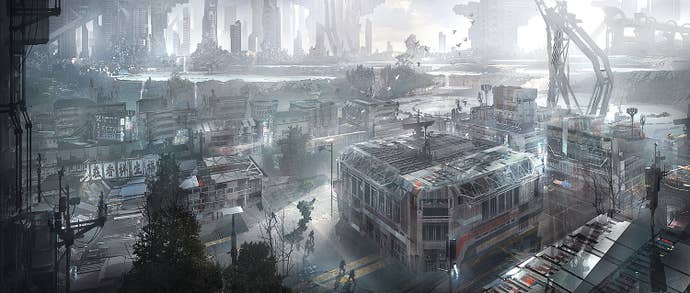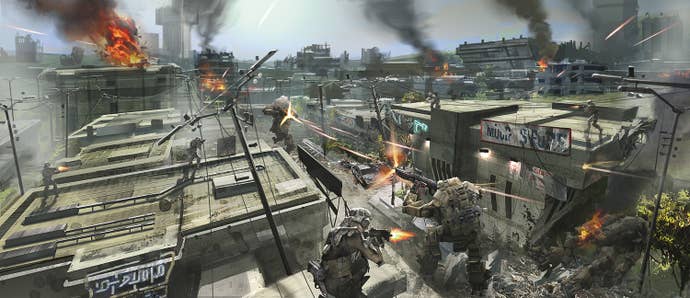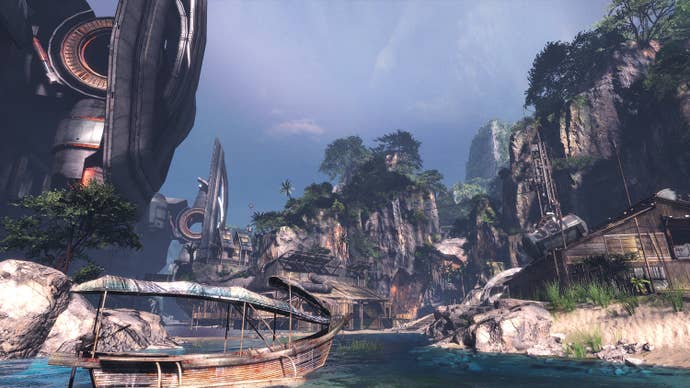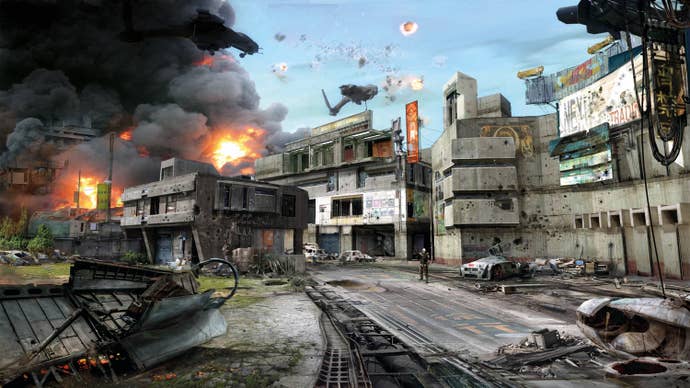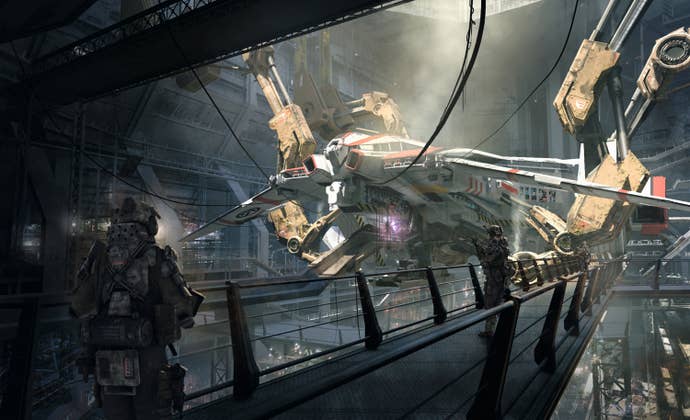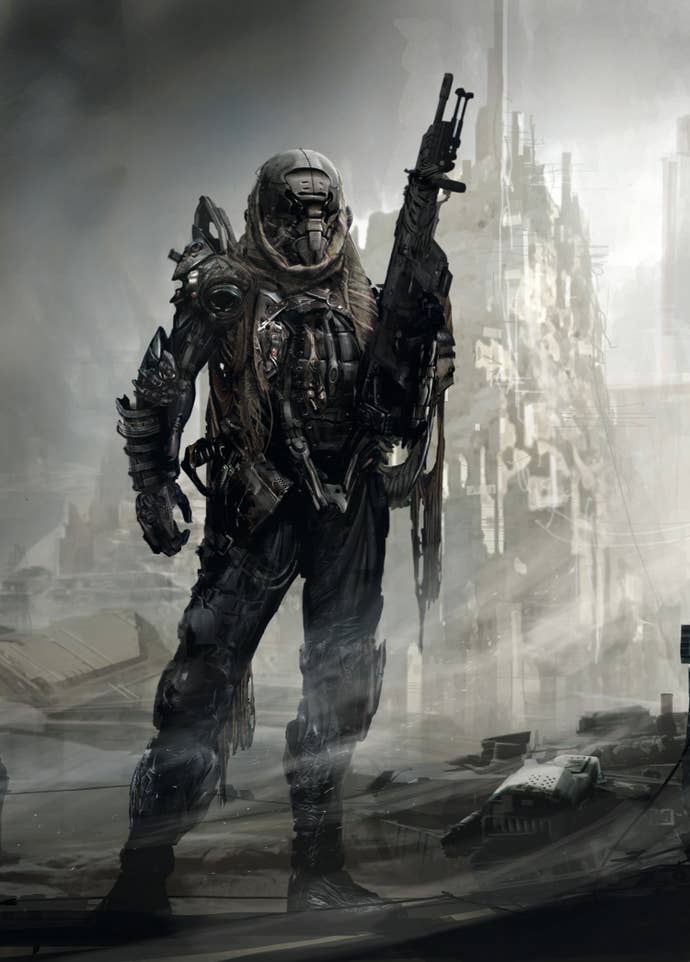The art of Titanfall: directing gameplay through visuals
From tractors and tanks to manga and movies, lead artist Joel Emslie discusses the influences, game design and art functions of this year's biggest game.
Literally and figuratively, Titanfall is impressive on many levels. Not least among them is its art design, a blending of modern military, futuristic bi-pedal war machines and environments that range from otherworldly desert wastelands to the ruins of a fallen space station. Environments that, even more relevantly, support both flesh and blood humans and Gundam-sized mechs. Furthermore, this being the first game in a brand new franchise, and one running on new hardware, the visual design of the world and its character needed to be drawn from scratch.
"This isn’t gallery art where the viewer is expected to interpret the content. Gameplay and artistic direction have to co-exist as the game is created in order for the entire universe to feel cohesive."
"We are very influenced by other works of science fiction and futuristic works, but we tend to put a heavy layer into our work that’s inspired by contemporary elements," says Joel Emslie, lead artist on Titanfall.
"Our influences range from movies, manga and anime to tractors, tanks and jets. I think the successful parts of our art style and game are the ones that are really out there, but you tend to take them for granted because of how much you can relate or believe them. That’s always different from person to person but hopefully we have found a visual sweet spot somewhere along the way."
Relating to the content is of paramount importance in a game like Titanfall where you're fighting as part of team. If you didn't connect in some way to those characters around you, or didn't believe that they fit into the world, then ideas of companionship, solidarity and the desire to win would fall down - crushed by the visual side's inability to have you suspend your disbelief for the duration of a match.
"When you are creating something new for a large audience there is an inherent understanding that you want your subject matter to resonate with your intended audience and be as relatable as possible," continues Emslie.
"This type of art isn’t gallery art where the viewer is expected to interpret the content. Gameplay and artistic direction have to co-exist as the game is created in order for the entire universe to feel cohesive. The art of Titanfall in many ways needs to communicate directly with its fan base and help ground the gameplay and really support the fun as much as possible."
Indeed, the idea of grounding the gameplay could be applied to almost all games. Games must have gameplay and the visuals must act primarily to facilitate and/or strengthen that. As games have matured and evolved into much bigger, more complex propositions that take an enormous amount of resources to produce and maintain, we've seen studios encourage internal departments to work much closer together where possible.
In Respawn's case, that interconnected system of communication is even more important than it is for most other studios working on 'AAA' titles. As Emslie explains, the size of team forces them to think as a unit. It also helps prevent them getting slowed down by sheer weight of numbers:
"We essentially had to create environments that support two games seen from two entirely different vantage points. All the scales of the game need to co-exist with fidelity to match."
"The art department works closely with every department within Respawn. The goal is to know what all the other departments are doing in real time so we can better synchronize our efforts. Respawn is a small team compared to most development studios out in the industry. We are about 75 core dev working on Titanfall.
"This smaller size lets us communicate and execute the direction of our project rapidly. We can adjust to ideas, art and gameplay that’s potentially not working. This is all key to maintaining the overall mood of Titanfall."
Arguably the biggest single element that contributes to Titanfall's 'mood' is the fact that pilots and titans occupy the same map at the same time. This asymmetric gameplay approach has an enormous impact on how you act in any given match - whether on foot as a pilot, or buckled into a titan - and is the key selling point for the majority of players.
This creates problems from a visual perspective, however. Not only does the game have to work whether you're inside a titan or not, but it has to feel like you're part of a fully functioning world and gaming space. It's in this regard that the Xbox One's improved performance was put to good use.
"Increased performance and capabilities definitely altered our artistic approach but in different ways than you would think," Emslie explains. "Titanfall in many ways is a very experimental game. with mechanics that needed to be justified through the art.
"One example I can point to is how we used the power of the Xbox One to create large environments that supported titans with enough detail to complement the pilots of the game that exist on a smaller human-sized scale. We essentially had to create environments that support two games seen from two entirely different vantage points. All the scales of the game need to co-exist with fidelity to match."
That fidelity applies not just to visual quality, but also to the way players understand the environments and understand how to use it to their advantage. Given the frantic speed at which Titanfall sometimes operates, it's vital that the players can recognise at a glance both what is happening and what's possible in any given area.
"We put a heavy emphasis on presenting the player with visual cues on enemies, friendlies and how they can potentially navigate the environment," Emslie says. "A lot of the visual language is present in the game but at the same time we didn’t want to make it so obvious that it takes you out of the experience. The grunts, spectres and player controlled pilots all have a visual language that differentiates them as units in the world. All of this visual grammar is balanced towards how the game plays and feels to the end user.
"There’s always the danger of taking elements too far and frustrating players, one way to do that is make pilots too obvious. There are fun gameplay mechanics like being a pilot and blending into a group of grunts as cover and we don’t want to ruin those levels of sophistication."
"There are fun gameplay mechanics like being a pilot and blending into a group of grunts as cover and we don’t want to ruin those levels of sophistication."
This is very much in line with Emslie's earlier comments regarding the importance of art design serving the gameplay as a primary concern. Within such a structure you'd be forgiven for thinking that working on a game's art team is a restrictive process, one in which you're locked into a form of creation in which the single purpose of your designs is to help another element exist at all.
Emslie, however, sees such boundaries as a positive and uses the different sizes of the playable characters (titans and pilots) as an example of how using art to enable gameplay helps you think about design problems more clearly.
"A considerable amount of thought and energy went into making sure the environments compliment the scale of the titans. Both titans and pilots have their own separate metrics that define the scale of the environments and the objects within them. We never look at those metrics as restricting the art direction. We tend to look at artistic boundaries as a way to work within an understandable space. Having good boundaries also helps us complete tasks in a more objective way."
The biggest success of Titanfall, perhaps, is just how well it manages to communicate, right the from start, the limitations and possibilities of its playing space. Before Titanfall most of us were not used to playing a first-person shooter which gives you the option of taking advantage of two such different forms of gameplay. And yet, getting to grips with how Titanfall works is a painless and intuitive task.
It's the quality of the art direction that we've got to thank for that.

